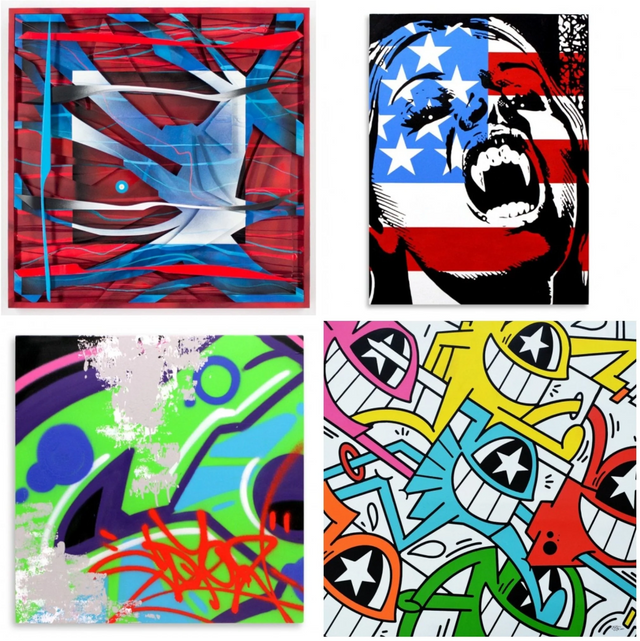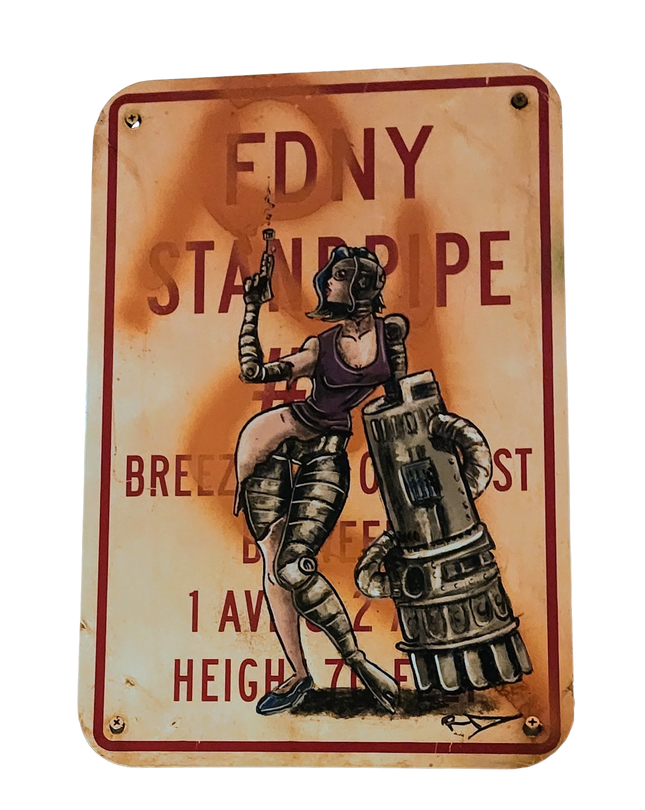
Painting Original Artwork

RD-357 Real Deal Techno Standpipe Original Street Sign Painting by RD-357 Real Deal
Techno Standpipe Original Street Sign Painting by RD-357 Real Deal Spray Paint Mixed Media is one of the kinds of artwork on New York City FDNY Standpipe Notice Sign Pop Graffiti Street Artwork. 2014 Signed Spray Painting Original Artwork on Real Reclaimed NYC Fire Fighter Metal Urban City Street Sign Size 13x18 Futuristic Sci-Fi Cyborg Robot Woman with Guns & Future Weapon Arm Replacement—RD Tag in Rust Red. RD-357's Techno Standpipe: A Metaphor of Futurism in Street Art The original Techno Standpipe street sign painting by RD-357, also known as Real Deal, is a compelling piece of street pop art that seamlessly blends technology and urban grit. Created in 2014, this work of art reimagines a New York City Fire Department standpipe notice sign as a backdrop for a dystopian narrative. The piece, signed by RD-357, features a futuristic sci-fi cyborg woman armed with advanced weaponry, conveying powerful themes of transformation and the intersection of humanity and technology. Symbolism and Significance in RD-357's Artwork In 'Techno Standpipe,' the cyborg woman symbolizes the evolving relationship between humans and machines. Her robotic arm replacement, depicted with meticulous detail, suggests enhancement and perhaps the loss of human elements, a theme that resonates deeply in an era where technology increasingly interfaces with every aspect of life. The choice of a standpipe sign, an emblem of safety and regulation, contrasts with the unrestrained and anarchic spirit of the cyborg, creating a visual paradox that challenges the viewer to consider the implications of technological advancement. The RD tag in rust red serves as the artist's signature and integration into the piece's aesthetic, echoing the rust and decay that often accompany urban infrastructure. This artwork, measuring 13x18 inches, uses spray paint to bring to life the textures and tones of metal and flesh, bridging the gap between the industrial and the organic. RD-357's Technique and Artistic Vision RD-357's execution of 'Techno Standpipe' demonstrates a masterful use of mixed media, combining the stark, flat surface of a metal sign with the depth and dynamism of spray paint. The artist employs shading, contouring, and color contrasts to give the cyborg figure a three-dimensional appearance, projecting her out of the sign's flatness and into the viewer's space. The shadows and highlights create a sense of movement, suggesting action and energy, symbolic of street pop art's dynamic nature. The artwork's gritty realism, underscored by the wear and tear on the sign itself, reflects the urban environment's influence on RD-357. Using a real street sign repurposes the found object and contextualizes the art within the living, breathing cityscape. This piece thus becomes a conversation between the artist, the medium, and the ever-changing urban landscape. The Cultural Resonance of 'Techno Standpipe' As a piece of street pop art and graffiti, 'Techno Standpipe' carries within it the pulse of contemporary culture, where concerns about the encroachment of technology into the human sphere are ever-present. RD-357 captures this zeitgeist, presenting a future vision that is both a warning and a wonder. The artwork invites introspection on the viewer's part, urging them to contemplate the direction in which society is headed. RD-357, whose real name and country of origin remain anonymous, maintains the tradition of street artists who operate under pseudonyms, preserving the mystery and rawness central to the genre. The 'Techno Standpipe' is a bold statement within RD-357's oeuvre, a one-of-a-kind piece that embodies the transformative and provocative power of street pop art and graffiti artwork. It is a visual manifesto of the times, a metallic cry from the city's heart that resonates with modern existence's complexities.
$600.00


